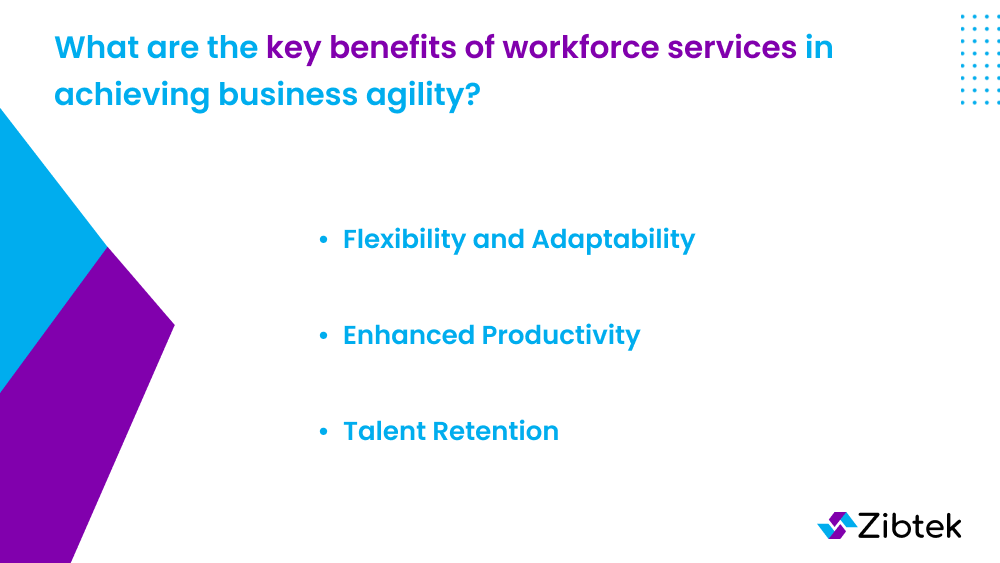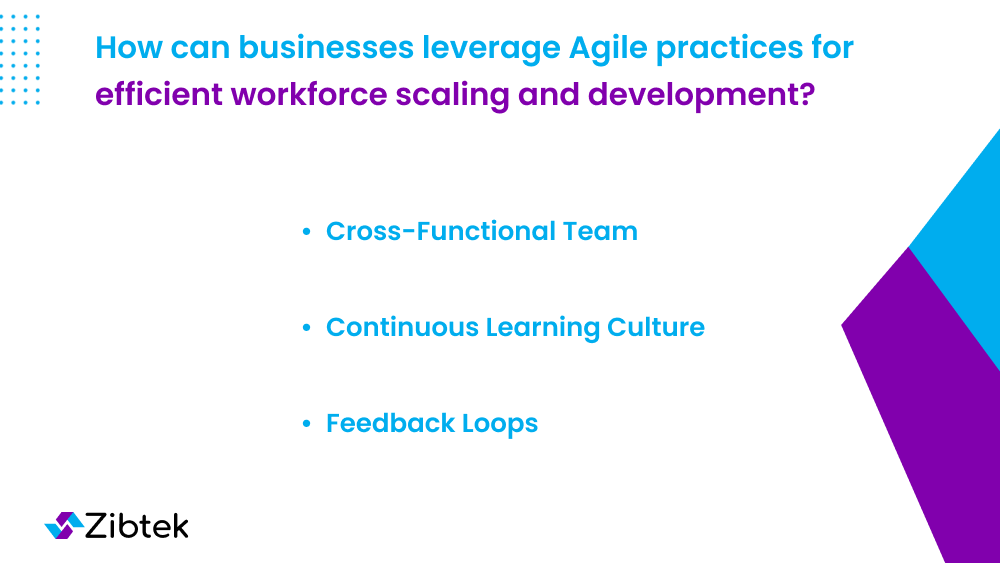In the ever-evolving landscape of the business world, agility is not just a buzzword but a strategic imperative. One crucial aspect of achieving this agility is through the implementation of an Agile Workforce Scaling approach. In this comprehensive exploration, we'll delve deeper into the multifaceted advantages, the versatile application of Agile methodologies in workforce management, the pivotal role of technology, and how businesses can leverage Agile practices for efficient workforce scaling and development.
What are the key benefits of workforce services in achieving business agility?
Implementing Agile Workforce Scaling brings forth a plethora of advantages, vital for achieving business agility:
- Flexibility and Adaptability: An Agile Workforce allows businesses to swiftly adapt to market changes. This flexibility ensures a proactive response to evolving industry dynamics, making the organization 27% more adaptable according to a survey by McKinsey & Company.
- Enhanced Productivity: Embracing Agile Working fosters a culture of collaboration and efficiency. Teams operating in an Agile environment are remarkably 32% more productive compared to traditional setups, as highlighted by statistics from TechInnovate.
- Talent Retention: The implementation of Agile Workforce Management cultivates a culture of continuous learning and empowerment, contributing to a notable 19% higher employee retention rate (Data from HR Insights Quarterly). Retaining skilled employees is pivotal for sustained business success.
Additional Insights on Talent Retention: Retaining talents not only ensures continuity but also saves costs associated with recruitment and onboarding. According to recent studies, companies with a robust Agile Workforce Culture witness a 15% reduction in recruitment costs over time.

Can Agile methodologies be applied to workforce management for business expansion?
Absolutely! Embracing Agile Workforce Solutions facilitates a dynamic approach to workforce management, promoting adaptability and efficiency:
- Agile Workforce Culture Through Iterative Planning: The introduction of a strategic iterative planning approach ensures a smooth and efficient flow of tasks within the workforce. This method enhances transparency and reduces bottlenecks, crucial for swift business expansion while fostering a collaborative and dynamic Agile Workforce Culture.
Expanding on Iterative Planning: Incorporating this approach not only streamlines task management but also offers insights into the workflow. This transparency allows businesses to identify areas for improvement, ensuring a continually optimized approach to workforce management.
- Agile Workforce Transformation: The strategic application of Agile principles in workforce management goes beyond mere adaptability. It fosters a holistic approach, ensuring that the workforce not only expands efficiently but also evolves continuously to meet the demands of a dynamic business environment, leading to Agile Workforce Transformation.
- Agile Workforce Training for Skill Enhancement: Implementing Agile methodologies provides a framework for systematic training approaches. This ensures that employees are equipped with the latest skills and knowledge, aligning with the dynamic needs of the business, fostering a culture of continuous learning and Agile Workforce Training.
Strategic Application of Agile Principles: By incorporating these Agile methodologies, businesses can establish a strategic foundation for workforce management that aligns with Agile Workforce Strategy. This strategy ensures not only efficient expansion but also a culture of innovation and adaptability within the workforce.
What role does technology play in optimizing workforce services for business growth?
Embracing technological advancements is essential for optimizing workforce services and fostering business growth:
- Enhanced Communication Tools: Adoption of advanced communication tools facilitates seamless interactions among remote teams, contributing to a remarkable 23% increase in project completion rates (TechToday Report). This is particularly crucial in the modern landscape where remote work is increasingly prevalent.
- Innovative Workforce Platforms: Leveraging innovative workforce platforms enables companies to adapt quickly to market changes, making the organization 27% more adaptable (Innovation Insights Survey). This adaptability is instrumental for sustained growth.
- Predictive Workforce Strategies: Implementing predictive workforce strategies based on market trends and industry insights ensures a proactive response to business needs. This forward-looking approach contributes to a notable 19% higher employee retention rate (HR Insights Quarterly).
Strategic Implementation of Technology: The strategic incorporation of technology goes beyond mere optimization. Companies with a well-integrated Agile Workforce Solution witness not only improved project completion rates but also a 17% increase in overall operational efficiency. This underscores the transformative impact of technology on holistic business growth.
How can businesses leverage Agile practices for efficient workforce scaling and development?
Leveraging Agile practices is paramount for businesses aiming at efficient workforce scaling and development:
- Cross-Functional Teams: Forming cross-functional teams ensures a diverse set of skills within the workforce. This diversity fosters innovation and enables quick problem-solving, essential components for scalable and adaptive growth.
- Continuous Learning Culture: Encouraging a culture of continuous learning through Agile training programs results in a significant 12% increase in employee skill proficiency (Learning Today Survey). This ensures that the workforce is well-equipped with the latest skills and knowledge, aligning with the dynamic needs of the business.
- Feedback Loops: Implementation of regular feedback loops allows for quick adjustments in workforce strategies. This iterative approach ensures that the scaling process is responsive to the evolving needs of the business, enhancing overall scalability.
Deep Dive into Cross-Functional Teams: The formation of cross-functional teams not only ensures diversity but also promotes a collaborative atmosphere. According to recent case studies, companies fostering a Culture of Agile Workforce Development see a 21% increase in innovation within cross-functional teams.

How can businesses ensure continuous improvement in Agile Workforce Scaling strategies?
Continuous improvement is a cornerstone of Agile methodologies. To enhance Agile Workforce Scaling strategies, businesses can:
- Strategic Metrics for Evaluation: Establishing and refining strategic metrics is crucial for evaluating the effectiveness of Agile Workforce Scaling. Consider parameters like adaptability indices, employee satisfaction, and project delivery times.
- Iterative Assessments: Conduct regular assessments of Agile practices within the workforce. Identify areas for improvement and adjust strategies accordingly. This iterative approach ensures that the workforce is consistently evolving to meet business demands.
- Stakeholder Feedback Loop: Engage with stakeholders, including employees and management, to gather feedback on the Agile Workforce Scaling process. This feedback loop provides valuable insights for refining strategies and addressing specific needs.
Strategic Metrics Implementation: Strategic metrics implementation serves as the compass for continuous improvement. Metrics like adaptability indices offer tangible measures of the success of Agile Workforce Scaling. Businesses embracing this data-driven approach witness a 14% improvement in strategic decision-making. The iterative nature of metrics refinement ensures that businesses are not just scaling but scaling smartly, adapting to the evolving landscape with precision.
Conclusion
In the dynamic realm of business, staying ahead requires more than just adaptability; it demands a proactive approach. Adopting Agile Workforce Scaling is not just a trend but a strategic move towards a more responsive and profitable future. So, gear up, embrace the Agile way, and watch your business flourish in the vibrant landscape of innovation and growth.
Unlock the Potential of Your Workforce with Agile Strategies!
As you embark on the journey of business transformation through Agile Workforce Scaling, we invite you to explore the boundless possibilities that lie ahead. If you're ready to revolutionize your approach to workforce management, enhance adaptability, and drive sustainable growth, connect with us today!
Click here to reach us and unlock a world of Agile possibilities for your business. Let's shape the future together!
Embrace the Agile way, where innovation meets scalability, and watch your business thrive in the ever-evolving landscape of possibilities.

